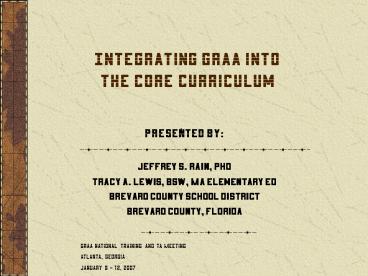Integrating GRAA into the Core Curriculum - PowerPoint PPT Presentation
1 / 10
Title:
Integrating GRAA into the Core Curriculum
Description:
Program adaptations to match target population (middle to high school students) ... to break into the high schools students ... Holiday Safety Campaigns ... – PowerPoint PPT presentation
Number of Views:58
Avg rating:3.0/5.0
Title: Integrating GRAA into the Core Curriculum
1
Integrating GRAA intothe Core Curriculum
- Presented by
- Jeffrey S. Rain, PhD
- Tracy A. Lewis, BSW, MA Elementary Ed
- Brevard County School District
- Brevard County, Florida
GRAA National Training and TA Meeting Atlanta,
Georgia January 9 12, 2007
2
Establishing Buy-In
- Overcoming teacher concerns/fears by using
teachers who participated before to help in
training new implementing teachers - Correlation of Sunshine State Standards to
lessons - Clear identification of what is in it for them
Not more work, but a replacement to what is
already in place - Correlation to A requirements for health
education under which SFDS falls and the District
Superintendents goals for Brevard County - Use of top-down recruiting approach
district-principals-curriculum coordinators-indivi
dual teachers - Use of evaluation data
3
Making the Connection Between Prevention and the
Curriculum
- Identification of where Lions Quest fit within
the existing curriculum - Glencoe Health book was not a prevention
curriculum, it held only one chapter of drug
education --- Now there is a substance abuse
prevention lessons with a service learning
component.
4
Teacher Training/Professional Staff Development
- Used experienced teachers as a resource to help
train new implementing teachers (Peer to peer
training) - Training provided teachers with inservice credits
towards recertification (similar to CEUs) - Teachers are trained 2x per year (Spring for
benefits and core Fall for re-iteration and
logistics)
5
Working with Program Developers on Fidelity Issues
- Program staff, evaluators and program developers
worked together to adapt program, while
maintaining fidelity, to the curriculum window - Program adaptations to match target population
(middle to high school students) - Adaptations were made prior to program inception
6
Evaluations
- Feedback Loop Use of evaluation data in
recruiting and buy-in - Preliminary results and learning points
- Planned adaptations, minimizing unplanned
modifications - Carefully balanced process between fidelity and
reality to break into the high schools students
elect class schedule (core and elective), block
scheduling, no prior comprehensive prevention
program - From process and prevention standpoint, our
initial opinion of why this has been successful
thus far (in health ed and fitness classes)
teachers have health and fitness as part of their
professional careers, and have prior exposure to
health-related, risk-reduction theory. Less time
is required to bring these teachers up to speed
with prevention theory, risk and resiliency,
healthy choices, etc.
7
Reinforcing the Message in Other Activities
- Program components, service learning projects
which exposed students school-wide - Other grant elements SADD Clubs gained exposure
as well and completed many projects school-wide - Red Ribbon Week
- Prom Promise
- Speakers/Demonstrations
- Poster contests
- Holiday Safety Campaigns
- After completing initial grant requirements for
implementation, all teachers have continued to
teach the curriculum without Federal funding
(sustainability) - Some teachers have expanded the program to
include all components of the curriculum and have
increased the scope of service learning projects
8
Measures Used
- Process Evaluation
- Focused on (1) fidelity to the intervention, (2)
time resources, (3) readiness qualifications
of staff, and (4) fidelity to management plan. - Tools used Key Informant Interview, classroom
observation, and Fidelity Assessment - Outcome Evaluation
- Self-report surveys (19 scales, including GPRA
measures Binge drinking, Disapproval of use, and
Perception of Harm)
9
Supportive Data
- Results from 6-month Follow-up Posttest
- Trends for Binge Drinking and Disapproval of Use
- Significant change in Best Friends Use
- Comparison of program adaptations support
fidelity - Attrition as process cue for posttest
10
Connection with Key Stakeholders Outside of the
School Setting
- Local Lions Quest Involvement
- Continued contact with Lions Quest International
- Service Learning at some of our schools
Students interviewed community members and also
created community resource guides - Building social capital
- For students in the community through service
learning projects - For community members connecting with students
through service learning projects - For schools as a result of students making the
connections with community members































